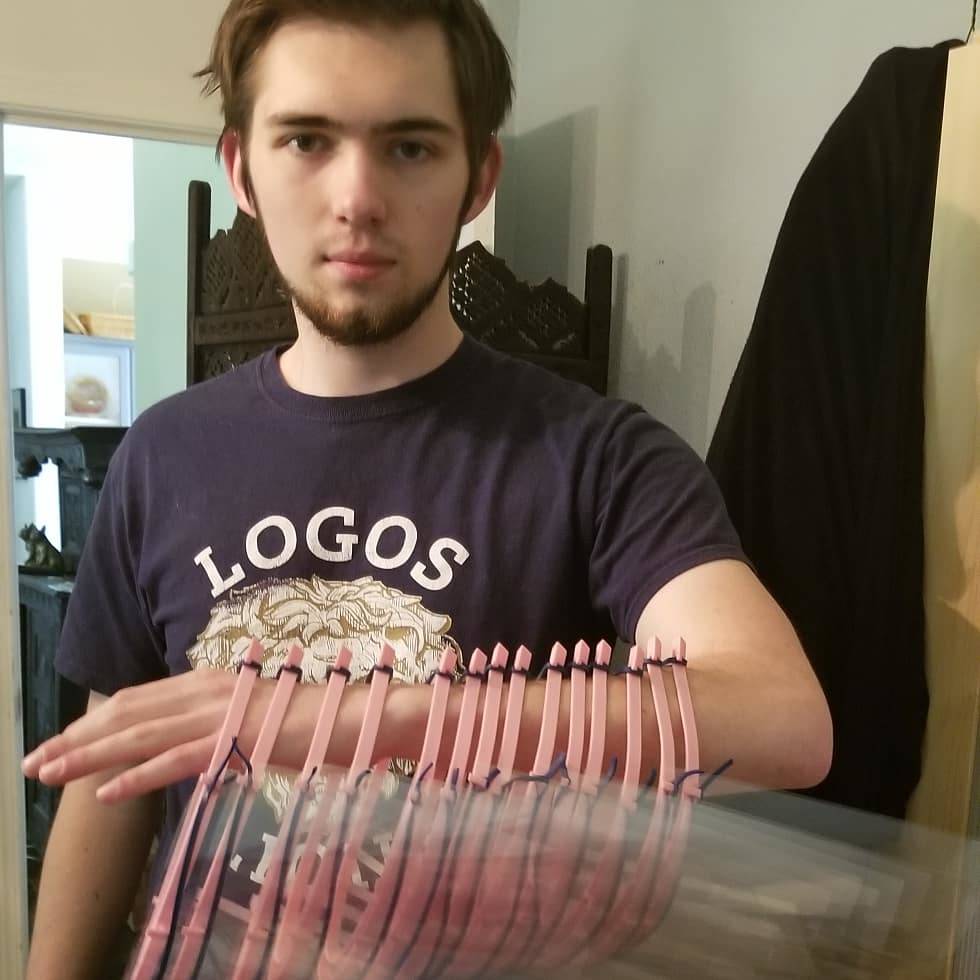SEQUIM — A Christmas present and an encounter with a social media post led two Sequim residents to help front-line nurses and at-risk locals alike fend off the 2019 novel coronavirus.
Brothers Aaron and Ryan Andrews are putting a 3-D printer they received last holiday season to use, producing face shields for people from Georgia to California and Canada as well as some Jefferson County residents.
“It’s been nice to have a way to feel productive and helpful in this crisis,” said Aaron Andrews, 20.
The idea started when the Andrews’ heard about the struggles of a family friend who is a nurse working directly with COVID-19 patients in Georgia.
The friend sent out a request for personal protection equipment (PPEs), specifically suggesting that anyone with a 3D printer could use them to make face shields. While his staff had some face shields they were having to share the PPEs and put a call out for equipment.
The family friend and wife also detailed their family’s struggles; being a front line worker means he essentially lives in the garage and has to wear significant protection at home in order to keep his family safe, Facebook posts indicate.
That hit home with Aaron and Ryan, 14, who see their father Ben Andrews — Clallam County Fire District 3 chief — go through a laborious process of disinfecting each day he comes home from work.
“He goes through a lot of work to get into this house,” Aaron joked.
The Sequim brothers soon got to work with the 3-D printer. The initial face shield design they found, Aaron said, was strong and sturdy but took between six to seven hours to complete. Soon, Aaron and Ryan found a more workable design that takes about two-and-a-half hours per piece.
The design with shorter turnaround time was actually better, Ryan said, because they were just as durable, lighter (about 40 grams) and more comfortable for the health care workers on long shifts.
“You actually forget about them if you’re wearing them (for a while),” Ryan said.
“We’re hearing back from the teams who are getting it how light they are,” said their mother, Leah Andrews.
The process of making the masks isn’t terribly involved, the brothers say; after cleaning and heating the machine and then adding the filament, a coil of plastic, the printer does much of the rest.
With help from Leah, Aaron and Ryan punched holes in the plastic shields. Finding material to complete the equipment was an issue, Leah said, as local stores had sold out of the elastic they’d need to secure the face shields to the users’ head; instead, the Andrews brothers turned to using heavy duty rubber bands that wound up working better than intended.
“(The nurses) were really happy,” Ryan said. “It was really cool to see how we could help out.”
Thanks to a social media post about their efforts, the Andrews boys started getting requests for face shields before their first order was completed.
They’ve now donated shields to nurses and nursing homes from Chimacum and Port Townsend, Vancouver Island and California, sending along video instructions on how to put the face shields together and take them apart for cleaning.
“There’s so much need for it everywhere,” said Aaron, a Peninsula College student who, like his brother Ryan is now, was homeschooled.
The brothers’ efforts have seen a reciprocal effect, getting donations of filament for their project. But acetate is still a tough product to find, Aaron said.
“We’ve been really supported through this,” he said. “They enjoyed helping (us) just as we’ve enjoyed helping people.”
Prior to making the protective equipment, Aaron and Ryan had used the 3-D printer to make headphone holders and soap dishes.
Aaron created a box that holds a deck of cards as a Christmas present while Ryan printed out a handle for a knife and Ben used it to replicate a broken refrigerator piece.
Now, they’re busy filling orders for PPEs. The brothers estimate they’ve completed about 75 shields … and counting.
“It wasn’t something they sought to do,” Leah said, “but (they) wanted to do something from home and feel safe.”
________
Michael Dashiell is the editor of the Sequim Gazette of the Olympic Peninsula News Group, which also is composed of other Sound Publishing newspapers Peninsula Daily News and Forks Forum. Reach him at editor@sequimgazette.com.

